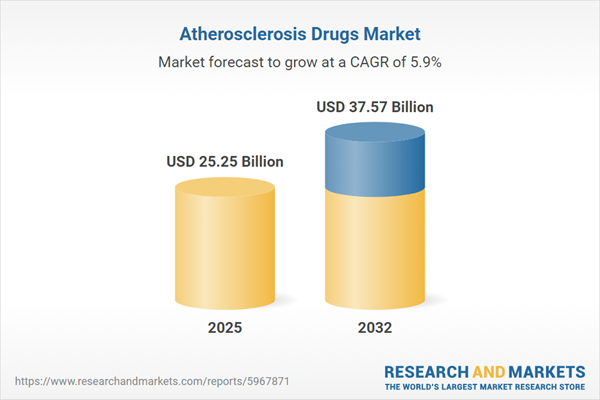Speak directly to the analyst to clarify any post sales queries you may have.
The atherosclerosis drugs market is in a pivotal period of transformation, driven by scientific innovation, evolving healthcare policies, and shifting global supply chain dynamics. Forward-thinking leaders in the pharmaceutical and biotech sectors are navigating increased complexity through advanced therapies and strategic collaborations, positioning themselves for growth in an environment of continual regulatory and technological change.
Market Snapshot: Atherosclerosis Drugs Market Growth and Trajectory
The atherosclerosis drugs market expanded from USD 23.82 billion in 2024 to USD 25.25 billion in 2025 and is projected to grow at a compound annual growth rate (CAGR) of 5.85%, reaching USD 37.57 billion by 2032. This sustained growth reflects a response to the increasing global prevalence of cardiovascular diseases, growing patient populations with metabolic disorders, and heightened demand for innovative drug modalities targeting lipid management and cardiovascular risk reduction.
Scope & Segmentation of the Atherosclerosis Drugs Market
This comprehensive report delivers a deep dive into market segmentation, regional analysis, and product categories shaping the competitive landscape. Detailed segmentation provides actionable insights for strategic planning and investment optimization.
- Drug Class: Bile acid sequestrants (cholestyramine, colesevelam, colestipol), fibrates (fenofibrate, gemfibrozil), niacin (extended release, immediate release), omega-3 fatty acids (docosahexaenoic acid, eicosapentaenoic acid), PCSK9 inhibitors (alirocumab, evolocumab), and statins (atorvastatin, pravastatin, rosuvastatin, simvastatin).
- Administration Route: Injectable (intravenous) and oral (capsule, tablet) therapies to support diverse clinical scenarios and enhance patient adherence.
- Distribution Channel: Hospital pharmacy, online pharmacy, and retail pharmacy networks ensuring widespread drug accessibility.
- Dosage Form: Capsule, injection, and tablet options available to suit various medical and patient care needs.
- End User: Clinics, home care, and hospitals, each representing distinct adoption and utilization patterns.
- Region: Americas (North America—including United States, Canada, Mexico—and Latin America, such as Brazil, Argentina, Chile, Colombia, Peru), Europe, Middle East & Africa (covering major countries in these regions), and Asia-Pacific (including China, India, Japan, Australia, South Korea, Indonesia, Thailand, Malaysia, Singapore, Taiwan).
- Leading Companies: Amgen Inc., Novartis AG, Pfizer Inc., Sanofi S.A., AstraZeneca PLC, Regeneron Pharmaceuticals, Inc., Merck & Co., Inc., Bristol-Myers Squibb Company, Bayer AG, Johnson & Johnson.
Key Takeaways for Senior Decision-Makers
- Pharmaceutical leaders are increasingly investing in precision therapies, including PCSK9 inhibitors and RNA-based drugs, to address evolving patient needs in atherosclerosis treatment.
- Strategic collaborations between pharma, biotech, and technology firms are expediting the development and launch of advanced therapies, reducing time to market and enhancing patient outcomes.
- Integration of digital health tools, such as patient monitoring and medication adherence solutions, is reshaping patient engagement and care pathways, offering operational and clinical efficiencies.
- Value-based reimbursement and outcome-based contracts are gaining adoption, prompting pharmaceutical players to demonstrate therapy effectiveness through real-world evidence and data analytics.
- Diverse and resilient supply chains are critical as companies respond to regulatory changes, shifting geopolitical climates, and new US tariff adjustments affecting pharmaceutical ingredient sourcing and costs.
Tariff Impact: Strategic Considerations Amid Trade Policy Change
Recent tariff adjustments in the United States have caused pharma manufacturers to reconsider supply chain strategies, balancing the need for domestic production against the complexity of global procurement. These changes add cost pressures and require adaptive risk mitigation through regional manufacturing alliances and alternative trade agreements, shaping future competitive advantage and market accessibility for atherosclerosis drugs.
Methodology & Data Sources
Findings in this report are built on a robust multi-step methodology, combining in-depth secondary research (peer-reviewed journals, industry white papers, regulatory filings) with primary interviews of key opinion leaders and supply chain experts. Advanced statistical models and cross-validation with policy trends ensure the reliability and transparency of all insights presented.
Why This Report Matters
- Support investment prioritization with granular insights into market drivers, therapeutic innovations, and segmentation strategies relevant to executive decision-making.
- Enhance strategic planning through region-specific analyses, helping organizations identify and seize high-value growth opportunities amid changing regulatory and policy landscapes.
- Equip leadership teams to respond to evolving healthcare and trade dynamics by highlighting actionable strategies across research, supply chain, and market entry.
Conclusion
The atherosclerosis drugs market is defined by rapid innovation, policy shifts, and the critical role of integrated strategies. Decision-makers who prioritize agile adaptation, strategic collaboration, and data-driven actions will be best positioned to succeed in this dynamic field.
Additional Product Information:
- Purchase of this report includes 1 year online access with quarterly updates.
- This report can be updated on request. Please contact our Customer Experience team using the Ask a Question widget on our website.
Table of Contents
3. Executive Summary
4. Market Overview
7. Cumulative Impact of Artificial Intelligence 2025
Companies Mentioned
The companies profiled in this Atherosclerosis Drugs market report include:- Amgen Inc.
- Novartis AG
- Pfizer Inc.
- Sanofi S.A.
- AstraZeneca PLC
- Regeneron Pharmaceuticals, Inc.
- Merck & Co., Inc.
- Bristol-Myers Squibb Company
- Bayer AG
- Johnson & Johnson
Table Information
| Report Attribute | Details |
|---|---|
| No. of Pages | 196 |
| Published | November 2025 |
| Forecast Period | 2025 - 2032 |
| Estimated Market Value ( USD | $ 25.25 Billion |
| Forecasted Market Value ( USD | $ 37.57 Billion |
| Compound Annual Growth Rate | 5.8% |
| Regions Covered | Global |
| No. of Companies Mentioned | 11 |









